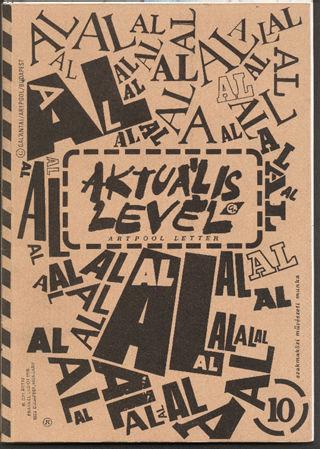AL 10. (Winter 1984) - SUMMARY 


3. “The Budapest Scene”, a lecture by Ákos Birkás at the closing debate of the exhibition-series “Image ‘84”.
In his statements, Birkás (a painter, leading figure of the Hungarian new painting, organizer of “Image ‘84”) analyzes the up-to-date situation which has produced many art-events, exhibitions and performances without any major changes of the two-decades-old official contra unofficial stance of the Budapest scene. In spite of the integration-complex characteristic of both sides of the scene, the problem remained the same during the last couple of years namely: the lack of exact national and international, that of Middle-East-European post-modern viewpoint.
7. László Beke’s lecture at the closing debate of the exhibition-series “Image ‘84”.
Beke (art-critic and historian) reflects upon what Birkás said about the situation. Beke emphasizes that the present moment is a historical and names Birkás as the hero of this period. On the other hand he points out that very important works were created in this period and the most precious value of these works were the risks of making them, in the sense of newness, exploration, inquiry and self-principle. His examples are; Birkás, Bak, Keserű and Min Tanaka, Peter Hutton, Kurt Kren.
10. “Pock and Balsa - Criteria of quality in the visual arts of the twentieth century”, a study by Willi Bongard (translated from English by Anna Kárpáti).
14. Invitation to the conference “Traditionality and Modernism in the Hungarian Art of the ‘70s and ‘80s”, held at Szentendre, organized by the József Attila Circle of the Hungarian Writers' Association.
15. “In the Absence of Avantgard”, a lecture by Péter Turcsány at the JAC conference.
Péter Turcsány (a poet) scans through the past and present situation of progressive Hungarian literature from a very special point of view. His argument deals with the reasons of the constant lack of creative literary workshops in the past 30 years. That's why - in Turcsány's view - there's no distinctive style and notion of poetics. He sharply criticizes the present situation as an artificially made scene of some literati with mostly very subjective drive. He says that the only solution is to form a new type of democratic and pluralistic literary life which of course would mean changes in the style of the art policy as a whole.
19. A study by Ádám Tábor: “Between the two ‘T-s’ under the Grass. Underground literature in Budapest in the ‘70s.”
The abbreviatory “T-s” come from the words Támogatás, Tűrés, Tiltás - Assistance, Tolerance, Ban, - used in the jargon of the Hungarian official art-policy. (So the title reads Between Tolerance and Ban … ). In his study Ádám Tábor (a poet and essayist) introduces those multi-talented artists whose main interests were to form a vivid connection between the neo-avantgardist attitude and a poetical language usage. He coins the term existential-cognitive literature, which works up the newest processes and phenomenas of the collective and individual psyche. He introduces the mostly unpublished authors: Algol, Lajtai, lsztray, Najmányi, Hajas, Balaskó, Molnár, - and as an ex-member of that school - he appreciates their magical-reflective style and their efforts to rediscover such traditions as chassid-mysticism, mahayana-buddhism and indian-shamanism. He concludes that the underground literature in the 70s produced new quality and, despite of the unknowness, its synchronicity with the future is more than relevant.
22. “The Emperor’s Message” poetical text by István Bá1int.
24. “Give Heed!” poems by Jenő Balaskó.
26. “The Personality of the Trinity” texts by László Algol (excerpts).
27. “The Production” a poem by Péter Lajtai.
28. “Freedom-Industry-Broadcast, 4th Channel” a manifesto by Tibor Hajas.
30. “What is to be known to training dogs?” a text by Tibor Hajas.
31-32. Excerpts from László Najmányi's book of poems entitled “Panic!”
34. “Film-Introduction” by Gergely Molnár.
36. “Remarks on the Hungarian Experimental Theaters” by János Szikora at the JAC conference, Szentendre.
38. Chronicle - A conversation between Miklós Erdély and István Antal on the film “Version” directed by Erdély.
Miklós Erdély, the key figure of the Hungarian Avantgarde made a film at the Béla Balázs Studio, which reconstructed the process of the “blood-charge” of Tiszaeszlár. The historical problem of the role of the Jewry in the Hungarian and East-European societies is a very sensitive point to touch nowadays too. Taking all these facts into consideration Erdély talks about his own creative motifs picking up the topic again and reacts very intelligently to the official ban of his film.
44. Private Correspondance between László Beke (art-critic and historian) and Sándor Radnóti (a philosopher) on some theoretical problems of artifacts, brought up by XXth century art and art history. (Part One).
Beke’s standpoint is that there’s only one direction Art has to move forth, even if reducing its own materiality by self-destruction, that is towards the Absolute. Radnóti thinks that Art must get back from those edges, making its own alienation relative, maximizing its energy instead of making it absolute.
49. A publicity brochure of Infermental III., the third edition of this international magazine on video-cassettes, written by László Beke.
50. Dixi - Tamás Papp: A Manifesto for Moebius Magica, a Light Show and Genre Painting. The event was at the University Stage on 12th May, 1984.
51. AL 1-9: Table of Contents.